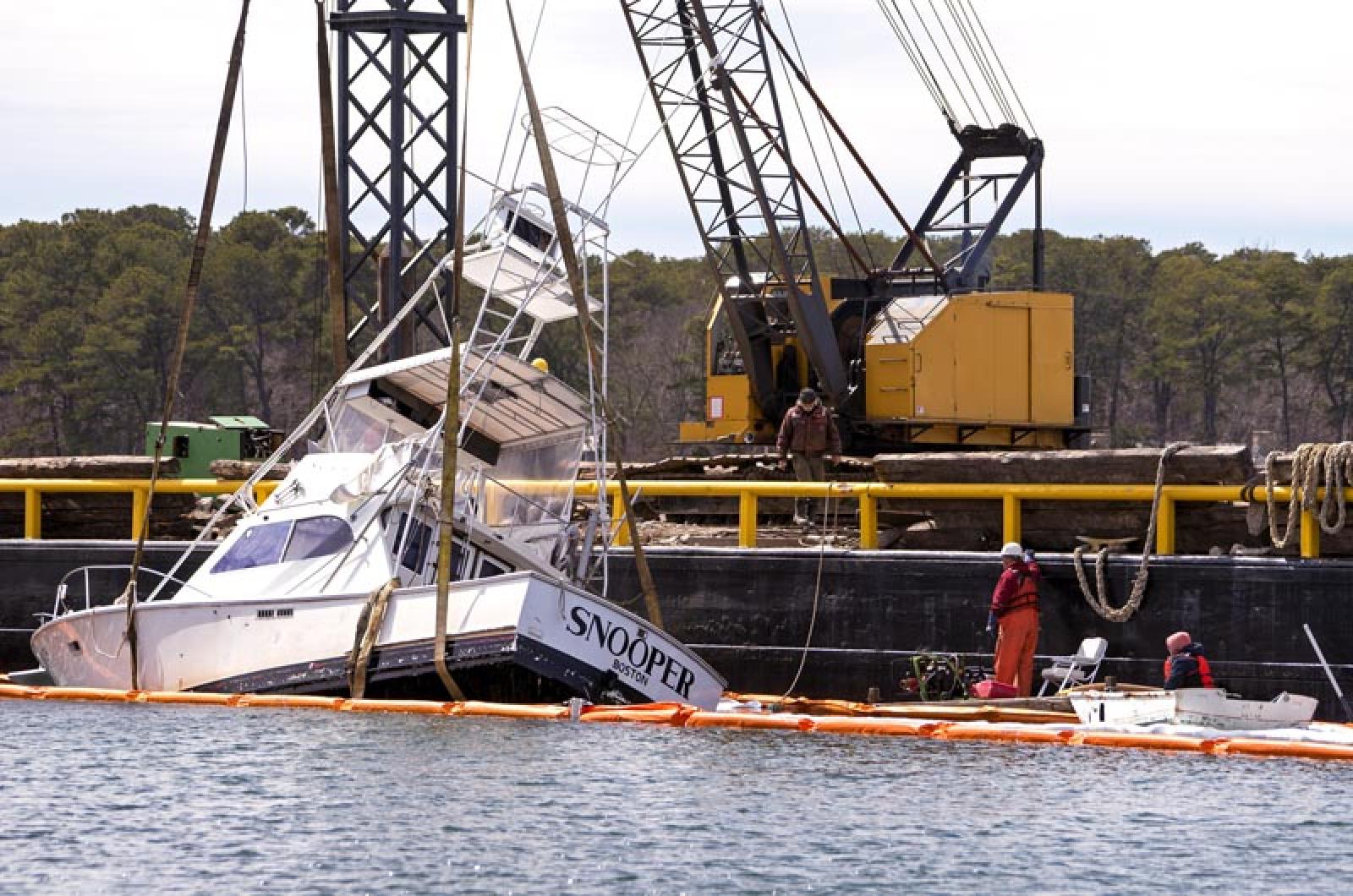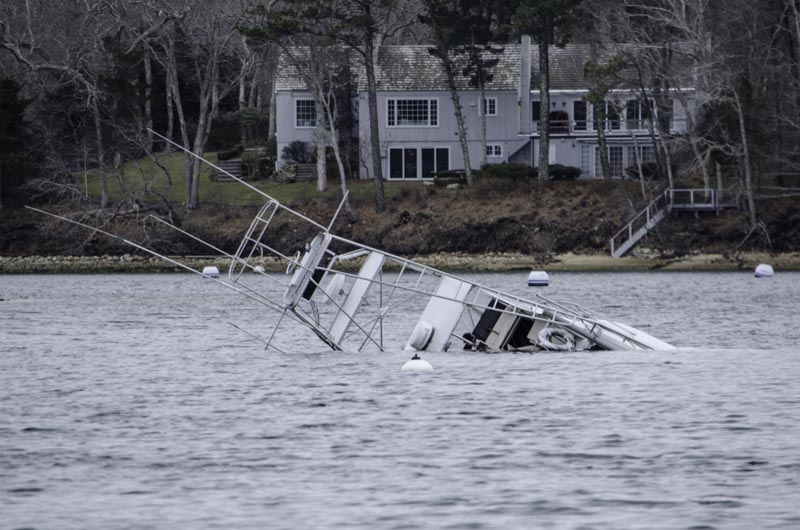A diesel fuel spill from a sunken sport fishing boat in Lake Tashmoo was contained early this week with what is believed to be minimal damage following a response from town, state and Coast Guard officials.
Shellfish beds remain closed while state biologists continue to assess environmental impacts from the spill.
According to an initial assessment at the scene by oil spill response teams from the Coast Guard and the Massachusetts Department of Environmental Protection (DEP), less than 20 gallons of diesel fuel spilled into the ecologically sensitive saltwater pond. Ronald Barry of Falmouth, the owner of the 33-foot vessel named Snooper, estimated there was about 150 gallons of fuel on board when the boat sank on its mooring in about 10 feet of water near the head of the pond sometime late Sunday or early Monday morning.
The county communications center received a call about the sunken vessel at 9:24 a.m. Monday. Tisbury fire chief John Schilling and shellfish constable Danielle Ewart responded to the scene a short time later, but detected no contamination coming from the boat. By 10:30 a.m., however, a large section of the pond on both sides of the Lake street boat landing was covered with a multicolored sheen of diesel fuel floating on the surface, and a small amount of fuel washed ashore. The sheen spread over several active shellfish beds, where commercial and recreational fishermen harvest softshell clams and quahaugs.
Assistant harbor masters John Crocker and Jim Pepper arrived at the scene at about 10:30 a.m. Harbor master Jay Wilbur was on vacation.
Local fishermen helped deploy an absorbent boom along the Lake street dock, but by then the sheen already stretched well past the dock. The boom is stored at the dock for such an emergency.
At approximately 11:10 a.m., a Tisbury fire truck arrived towing a fire department skiff. Fire and harbor personnel launched the boat and arrived at the sunken vessel at 11:23 a.m., where they worked to plug a fuel tank vent believed to be the source of the leak.
“What we believe is when the tide got to a certain point, it went over the vent hole, and that’s where the leaks came out,” Chief Schilling said later.
By about 11:30 a.m., Department of Public Works employees arrived towing the town’s oil spill prevention and response unit, a trailer packed with safety equipment including absorbent blotting pads and a large scale containment boom. Aided by Vineyard Haven Steamship Authority terminal manager Richard Clark, who has trained with the boat line on oil spill response, harbor, DPW, and fire personnel deployed the boom along the shoreline from the dock to a point about 200 yards north. They also began spreading blotting pads in the water and along the shoreline, where they began soaking up the pink-dyed diesel fuel.
Later in the afternoon, part of the boom was redeployed to form a ring around the sunken vessel as a precaution, though no further fuel leaks were detected according to Chief Schilling.
At their meeting Tuesday selectmen praised the response, although some local fishermen who make their livelihood from Lake Tashmoo were more critical.
Selectman Melinda Loberg, who works as a paramedic and is active in waterway issues, was at the scene Monday.
“Given the limits of the town’s equipment and personnel, I think they did an excellent job,” Mrs. Loberg said. “By the time anyone saw this, it was a matter of the horse had left the barn, and how can we stop it from spreading.”
Jeff Canha, a commercial fisherman, had a different view.
“There was just not proper response time,” he said. “The whole thing could have been contained. That boat should have been contained the minute it was under water. It’s all a matter of preparedness, it’s also a matter of action. You can have all the preparedness you want, but it’s a matter of moving your feet.”
David (Tubby) Medeiros was also critical. “It’s a threat to our livelihood,” he said. “It could have been avoided. The coordination was horrible, horrible, horrible. Nobody knew who to talk to.”
Chief Schilling said he will lead a thorough after-event examination to assess the town’s response, but already a consensus was emerging about the need for more training and practice. It has been several years since the town harbor, shellfish, fire and DPW staged a drill simulating an oil spill, and that drill focused on the outer harbor near Lagoon Pond drawbridge, Chief Schilling said. He said there is no lead town agency in charge of response in the event of an oil spill; instead, first responders operate under what is called “unified command,” which relies on departments with different expertise and training working together to contain a spill.
Mr. Crocker, an assistant harbor master who oversees Lake Tashmoo, said in retrospect there were things that could have been done better.
“The people that came down early didn’t really see any fuel leaking,” he said. “When I came down, it was obvious that fuel was leaking. What we probably could have done better was to be proactive, probably could have boomed the boat. I think we did a reasonably good job.” He cautioned the town is still gathering information about the response and said it is too early to draw conclusions.
According to some involved in Monday’s response, delays were caused by simple things like finding the keys to the equipment trailer, and arranging a truck to tow it to the scene.
“I think everyone would agree that drilling is a good thing and we should do it often,” Mrs. Loberg said. “I would like that they have a drill every year.”
On Tuesday, R.M. Packer Co. began the salvage effort, using a barge and large cranes to right the sunken vessel and pump water out. Commercial diver Heidi Raihofer, working in very cold water, helped secure lifting straps and lines to the vessel. By late afternoon, Snooper was afloat again, and towed by water to the Martha’s Vineyard Shipyard in Vineyard Haven, where it was lifted out and transported to the nearby R.M. Packer yard.
Coast Guard personnel from Station Menemsha were on the scene, as well as marine science technician Rory Jenkins of the Coast Guard Marine Safety Detachment on Cape Cod. The Coast Guard has ultimate authority over navigable waters. Also on hand was Julie Hutchinson of the DEP emergency response team.
On Wednesday, Mr. Barry, a former Vineyard resident who now lives in Falmouth, was working to clean out his boat and assess the damage. The vessel was moored in Lake Tashmoo for the past three years, but has only left the mooring once, according to the Coast Guard. Mr. Barry said he has had little time to enjoy his Harris Sport Fishing boat and described the last few days as difficult.
“Sleepless nights, overwhelmed, on an emotional rollercoaster,” he said. “I’ve got to do what I can to save it.”
He could face sanctions from the DEP, and he will be responsible for the cost of the salvage effort. He could also face sanctions from the Coast Guard, though the size of the spill and the cooperation of Mr. Barry with the cleanup effort will be taken into account.
“I haven’t seen any past violations,” said Mr. Jenkins of the Coast Guard. “The owner has been on the scene the whole time. It shows he’s been working hard, taking responsibility. I’ve seen plenty of sunken boats where the owner didn’t want to have anything to do with it.”
The week before the spill, six people harvested shellfish from the pond, according to the shellfish constable. One was Doron Katzman, a recreational fisherman who dug steamers from the left side of the landing on Sunday afternoon. When he went down to the landing on Monday, he found a layer of “ugly pink gel” coating the shoreline near at his usual spot. “It’s terrible, you know, it makes me very sad,” he said Tuesday by phone.
Biologist Greg Sawyer, who works for the state Division of Marine Fisheries (DMF), said before Lake Tashmoo can be reopened for shellfishing, a DMF biologist must visit the Island to assess the damage. Early next week, a biologist will walk the pond’s shoreline and take note of any visible oil sheen or polluted sediment. They may also dig up some shellfish and inspect and smell them for contaminants. “There is no standard test for hydrocarbons, so it may seem archaic but that suffices very well and that is what has been done in the past,” Mr. Sawyer said.
Shellfish are filter feeders, which means they eat particles floating in the water that passes through them.
The cold spring weather may have helped mitigate any possible environmental damage. In low water temperatures, the metabolic rate of shellfish is minimal, so when they detect something foreign in the water, they will shut down, Mr. Sawyer said. “They will sense that there is something wrong in the water,” he said.
Preliminary reports suggest that the spill’s impacts on pond life of all kinds are minimal. “As long as you get some sun, some wind and some tidal action in the pond, it will dissipate quickly,” Mr. Sawyer said.
Had the entire 150 gallons leaked into the pond, “it would have been a much different story,” Mr. Sawyer said.
In cases where pollutants remain in the water over the long-term, shellfish either starve or are forced to ingest some of the fuel. Shellfish larvae are most vulnerable to fuel pollution because they tend to hang near the water surface where diesel fuel floats. Fortunately, at this time of year, there isn’t any larvae in the water yet, said Martha’s Vineyard Shellfish Group director Rick Karney.
“The fact that this didn’t happen in the summer you might say is a good thing,” Mr. Karney said.











Comments (1)
Comments
Comment policy »